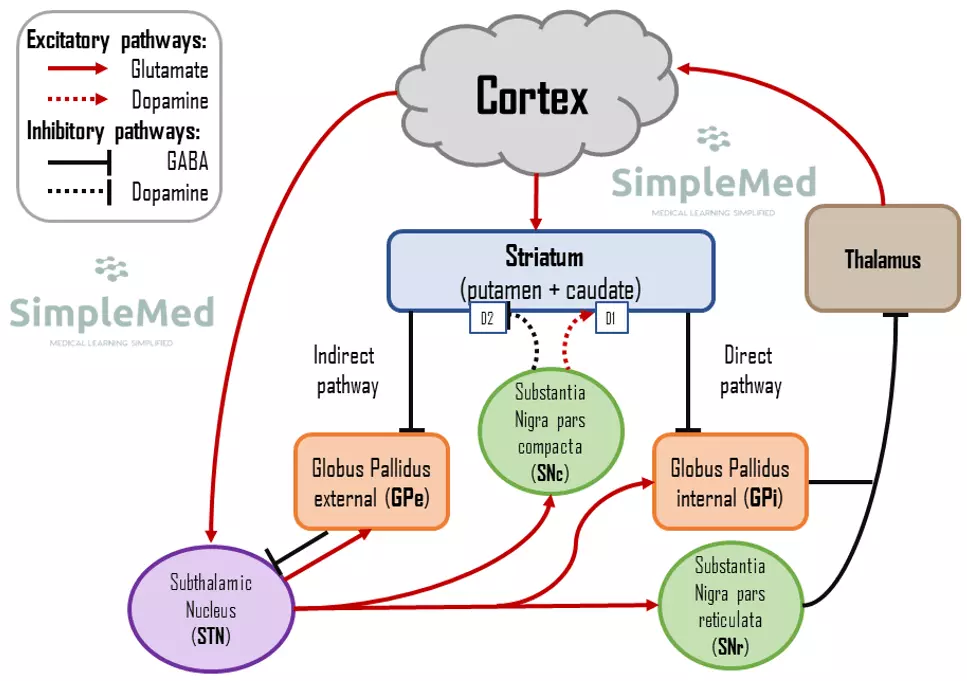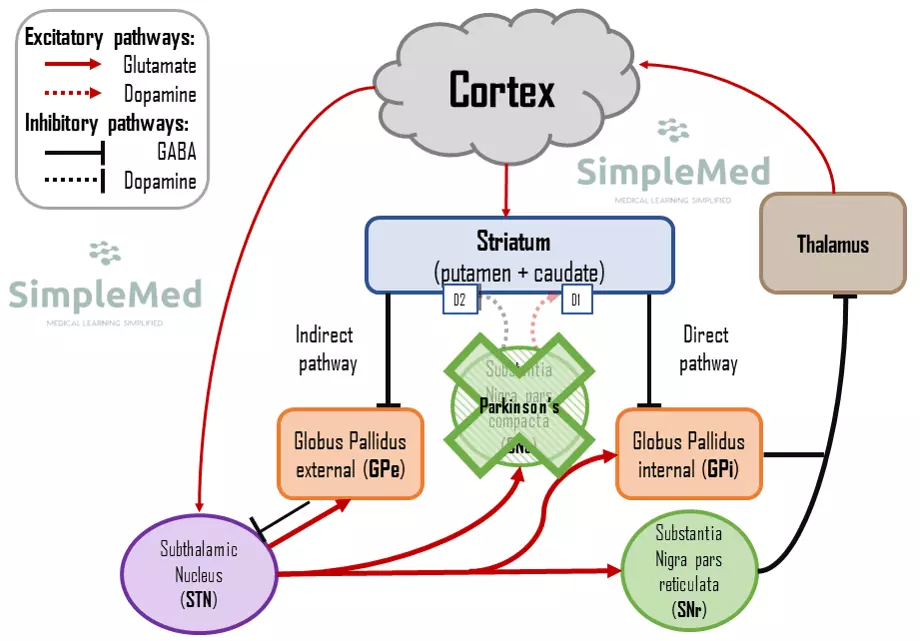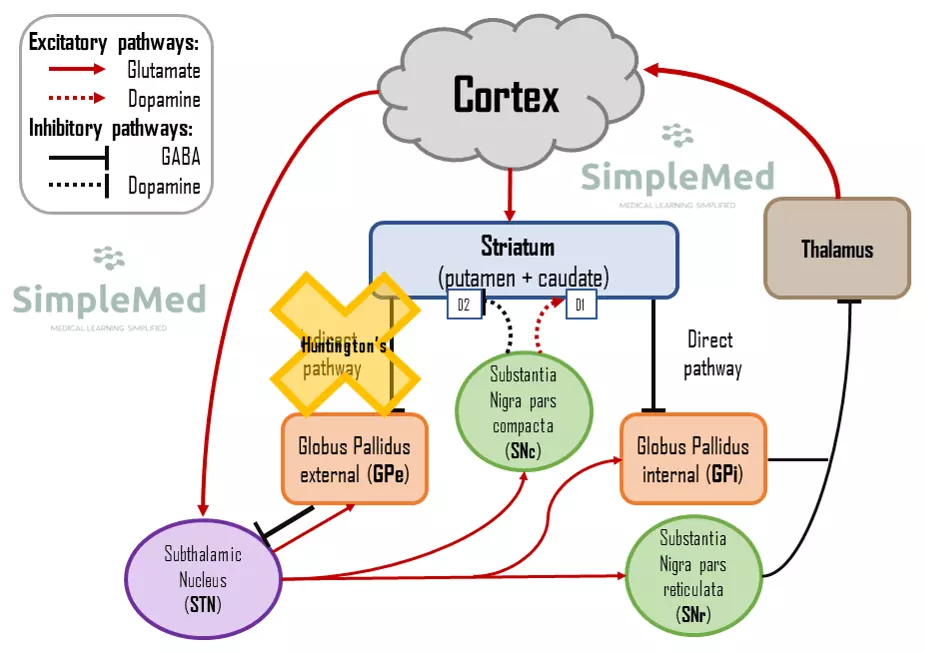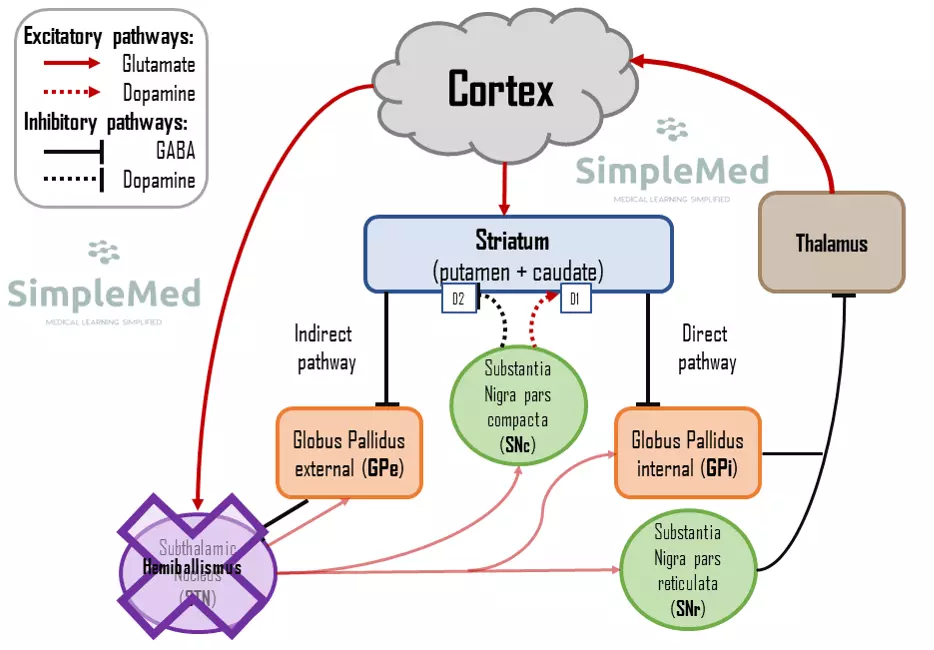Next Lesson - Infections and Prion Disease
Abstract
- The extrapyramidal motor system helps the cortico-spinal system with finetuning voluntary movement.
- Basal ganglia are a group of nuclei deep within the brain that interact with each other using excitatory and inhibitory neurotransmitters that ultimately interact with the thalamus and motor cortex.
- Some disorders of the basal ganglia include Parkinson’s disease, Huntington’s chorea and hemiballismus.
- Signs and symptoms of cerebellar disease are remembered using the mnemonic DANISH.
- There are a variety of causes that can result in cerebellar disease such as vascular events, MS, alcohol, and space-occupying lesions.
Core
To understand movement disorders, it is important to first get an understanding of the control centres of movement in the brain. Movement is primarily controlled by the cortico-spinal system which involves the pre-central gyrus, the descending tracts, and the spinal cord. Given these descending tracts form the pyramids on the ventral aspect of the medulla, neurologists refer to conditions involving this system as pyramidal disorders. These are explained in much more detail in our article Motor System, found here.
However, the motor system is much more complex than this, and in addition to the cortico-spinal tract, there is the extrapyramidal motor system that helps the central nervous system modulate and refine voluntary movement. Conditions affecting this system are referred to by neurologists as extrapyramidal disorders, as their pathology occurs outside the medullary pyramids of the corticospinal tracts. This article will focus on two components of this system: the basal ganglia and the cerebellum.
The basal ganglia are a group of nuclei deep within the brain (nuclei being a group of neuronal cell bodies). The basal ganglia communicate with the motor cortex via the thalamus, meaning increased thalamic activity increases cortical activity and vice versa.
It is made up of a number of structures:
- Substantia Nigra Pars Compacta (SNc) – the source of dopamine in the midbrain.
- Striatum – made up of two portions, and receiving inputs from the SNc and the cortex:
- Caudate Nucleus – C-shaped nucleus that sits in the lateral ventricles.
- Putamen
- Lentiform Nucleus – made up of two structures that are anatomically closely related but functionally very different:
- Globus Pallidus – has an internal and external segment.
- Putamen
- Subthalamic Nucleus
The exact role of the basal ganglia is still unclear and therefore is not a priority for understanding at this level.
One of its known effects is to fine-tune voluntary movements by reinforcing appropriate movements and inhibiting inappropriate ones. This is best visualised by thinking about a simple behaviour like kicking a ball – the direct pathway acts to facilitate appropriate actions (in this case hip flexion to bring the leg forwards) and the indirect pathway acts to inhibit inappropriate actions (in this case hip extension would be an inappropriate action).
The direct and indirect pathways are triggered by dopamine as it binds to excitatory D1 receptors to activate movements and inhibitory D2 receptors to prevent movement in the motor cortex. And, in turn, other components of the basal ganglia also have excitatory and inhibitory effects on one another, using mainly glutamate, as the excitatory neurotransmitter, and GABA as the inhibitory one.
Here is an attempt at showing the circuit in a simplified manner. You do not need to learn this in detail for medical school exams, but should be able to demonstrate an understanding of inhibitory vs excitatory, and apply this knowledge in the context of pathology explained later in this article.

Diagram - The motor pathways in the brain. It shows the different excitatory and inhibitory pathways, and the different neurotransmitters
SimpleMed original by Elena Perez
Ultimately, understanding this circuit can help understand how diseases that affect components of the basal ganglia result in different presentations of pathology.
Parkinson’s disease is one of the main extrapyramidal motor disorders. It occurs as a result of degeneration of the dopaminergic neurones in the substantia nigra pars compacta (SNc). This results in a loss of movement due to reduced excitation of the direct pathway and reduced inhibition of the indirect pathway.
Parkinson’s Disease has a number of classical symptoms:
- Tremor, typically described as ‘pill rolling’ – the mechanism of the tremor is unclear, but may be related to the dysfunction of the indirect pathway which would normally suppress unwanted movements.
- Rigidity, typically described as ‘lead pipe’ – another unclear mechanism, but may be related to lack of coordination between muscle groups.
- Bradykinesia or slowed movements – slowed movements are caused by loss of the excitatory pathway.
- Hypophonia or quiet speech results from bradykinesia of the larynx
- Micrographia or small handwriting results from bradykinesia of the hands
- ‘Mask-like facies’ is the typical description of the appearance of someone suffering from bradykinesia of facial muscles.

Diagram - The motor pathways in the brain, and the pathologies of Parkinson’s Disease involving the substantia nigra pars compacta
SimpleMed original by Elena Perez
Another common extrapyramidal disorder of movement is Huntington’s Chorea. Huntington’s Chorea (also known as Huntington’s Disease) is a genetic disease inherited via an autosomal dominant pattern that causes progressive symptoms starting between 30 and 50 years old.
It is associated with progressive decrease of inhibitory neurotransmission from the striatum via the indirect pathway, leading to increased activation of the thalamus and the motor cortex. This leads to increased involuntary movement referred to as chorea (dance-like movements). Other features include dystonia, loss of co-ordination and cognitive decline.

Diagram - The motor pathways in the brain, and the pathologies of Huntington’s Disease involving the progressive loss of the inhibitory neurones in the indirect pathway
SimpleMed original by Elena Perez
Hemiballismus is a very rare extrapyramidal movement disorder. It is the result of damage to the subthalamic nucleus (STN) which can happen from a lacunar stroke for instance, and it results in unilateral explosive or ‘ballistic’ movements.

Diagram - The motor pathways in the brain, and the pathologies of Hemiballismus involving the subthalamic nucleus
SimpleMed original by Elena Perez
The cerebellum is another component of the extrapyramidal motor system. The cerebellum sits above the fourth ventricle, meaning cerebellar lesions (e.g. tumours) can result in hydrocephalus (build-up of cerebrospinal fluid in the brain). It is divided into two lateral hemispheres, separated by the vermis (midline). The vermis is responsible for the trunk, whereas the hemispheres coordinate the corresponding ipsilateral side of the body. The cerebellum has three peduncles (different to cerebral peduncles). The superior peduncle connects to the midbrain, the middle peduncle to the pons, and the inferior peduncle to the medulla.
In very simplistic terms, the cerebellum works with the basal ganglia by deciding on the sequence in which the movements identified by the basal ganglia should be carried out. It does this by using sensory information on proprioception from the ipsilateral spinal cord and the contralateral sensory cortex. This means that signs of cerebellar damage occur ipsilaterally due to the decussation of the corticospinal motor pathway.
Signs and symptoms of cerebellar disease can be remembered by using the following mnemonic: DANISH.
- D – Dysdiachokinesia or the inability to carry out rapid alternating movements.
- This is thought to be as a result of sequencing for example pronation-supination-pronation-supination.
- A – Ataxia: poor muscle control and poor co-ordination.
- Often presents with an unsteady gait as a result of difficulty sequencing muscle contraction and loss of proprioceptive information from the lower limb.
- N – Nystagmus
- Flickering eye movements due to reduced co-ordination of the extra-ocular muscles of the eye.
- I – Intention Tremor
- A tremor that worsens as a target is approached.
- S – Slurred Speech
- Poor co-ordination of the laryngeal and tongue muscles.
- H – Hypotonia
- Unclear mechanism.
There are a variety of causes that can result in cerebellar disease or symptoms and some common ones useful to know include multiple sclerosis, alcohol, vascular events or space-occupying lesions.
Edited by: Dr. Maddie Swannack
Reviewed by: Dr. Thomas Burnell
- 2622

